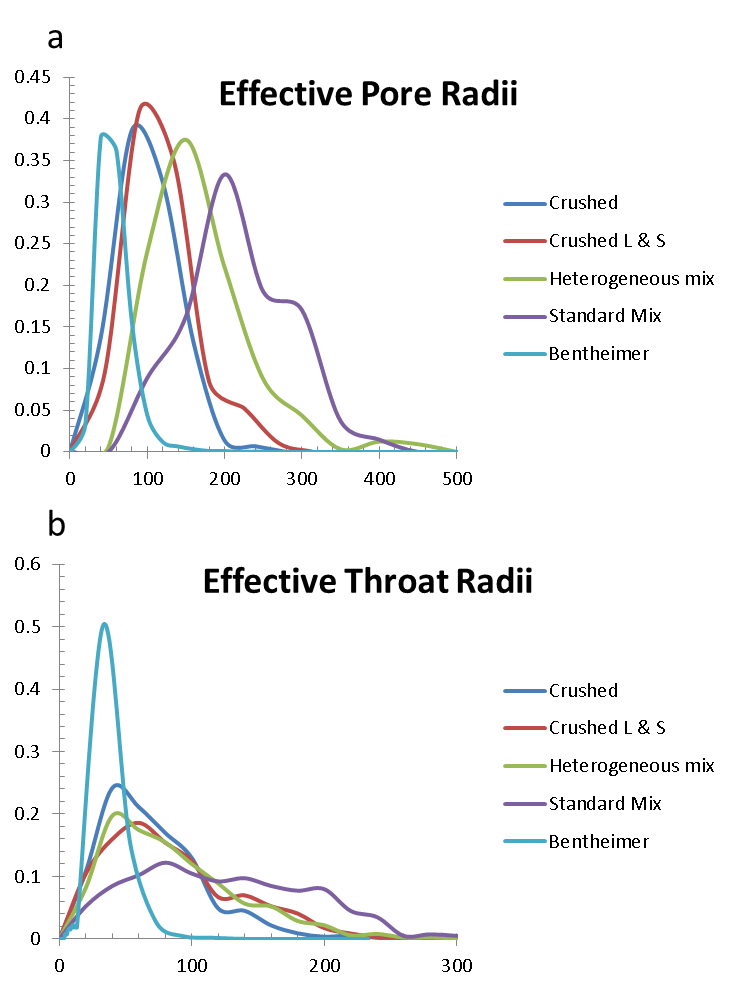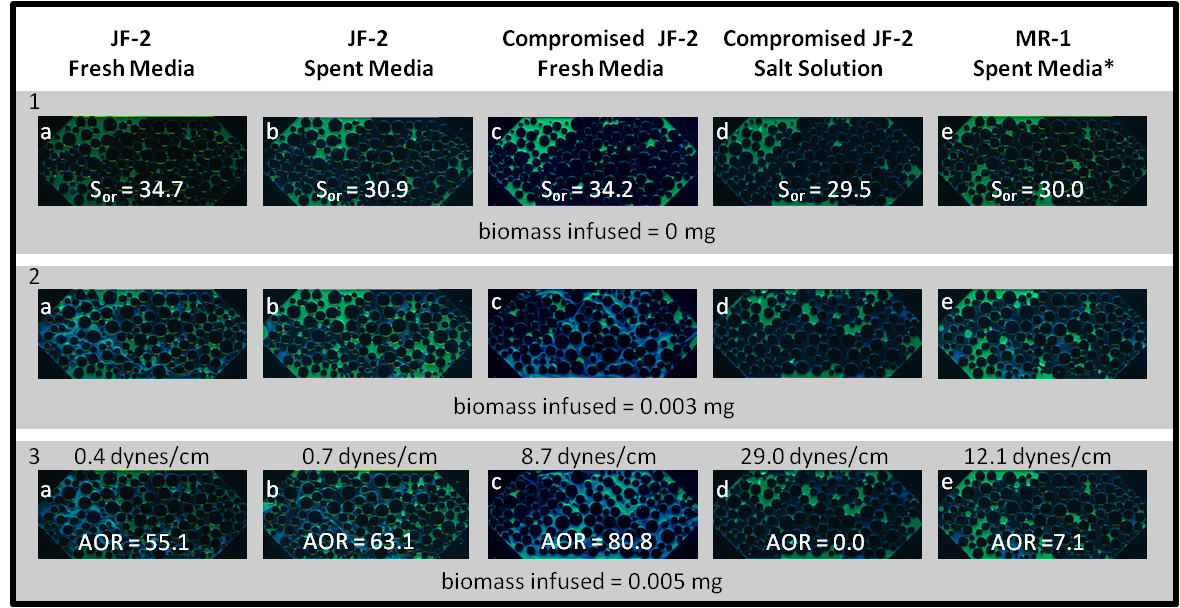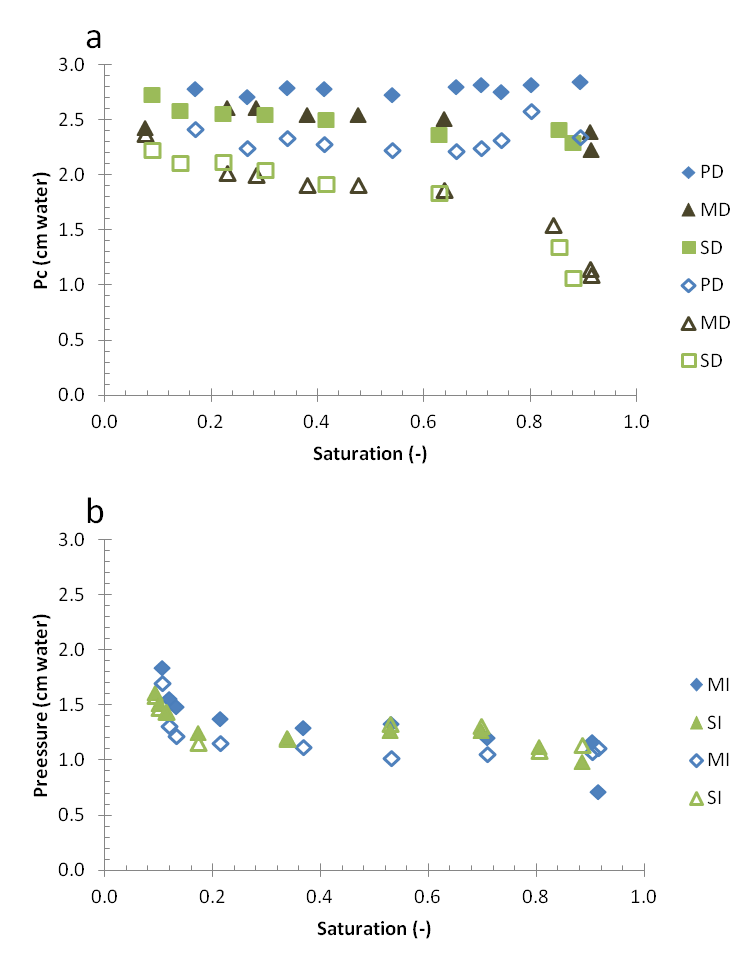www.acsprf.org
Reports: AC948505-AC9: Biosurfactant Enhanced Oil Recovery: A Pore-Scale Investigation of Interfacial and Microbial Interactions
Dorthe Wildenschild , Oregon State University
The work performed under this award uses fundamental research approaches to evaluate MEOR technology, specifically using in-situ microbially produced biosurfactants. It combines a novel 3D pore-scale imaging technique (high-resolution computed microtomography, CMT) and 2D micro-model work to improve understanding of the microbial and interfacial interactions at a very basic level.
Research results during the three years of this award are reported under the 4 following headers:
(1) Decoupling the mechanisms of MEOR using 2D micromodel studies, specifically the biosurfactant production and bioclogging mechanisms of MEOR
(2) Assessing the effect of wettability on MEOR recovery efficiency with x-ray microtomography
(3) Evaluating the effect of pore morphology on MEOR with x-ray microtomography
(4) Measuring interfacial curvature changes as a result of MEOR with x-ray microtomography
The award has supported a graduate student in pursuit of a PhD degree (expected graduation in Dec 2011), and has resulted in number of successful studies that have either been published, are under review, or will be submitted for publication shortly.
(1) Decoupling the mechanisms of MEOR using 2D micromodel studies, specifically the biosurfactant production and bioclogging mechanisms
Numerous mechanisms have been proposed in the literature through which microorganisms facilitate the mobilization of residual oil. Herein, we focus on the MEOR mechanisms of interfacial tension reduction (via biosurfactant) and bioclogging in water-wet micromodels, using Shewanella oneidensis (MR-1) that causes bioclogging and Bacillus mojavensis (JF-2) that produces biosurfactant and causes bioclogging. Results indicate that tertiary flooding of the micromodel system with biomass and biosurfactant was optimal for oil recovery due to the combined effects of bioclogging of the pore-space and interfacial tension reduction, see Figure 1.
Figure 1: Selected stereo microscope images for each flooding solution tested, results are reported as AOR per biomass infused into the micromodel (green = oil, white = biomass). Each column corresponds to a given flooding solution and each row corresponds to equivalent biomass infused.
(2) Assessing the effect of wettability on MEOR recovery efficiency with x-ray microtomography
Wettability is a major factor controlling residual oil saturation, and thus, it is essential to characterize reservoir wettability. Reservoir rock wettability can be altered by absorbable crude oil components (e.g. asphaltenes) which can lead to heterogeneous forms of wettability characterized by the term fractional wettability. A fractional-wet system is where a portion of the reservoir rock is strongly oil-wet, while the rest is strongly water-wet.
Figure 2: Isosurfaces of the oil/water interface after water flooding (a1, b1, and c1) and after MEOR (a2, b2, and c2) for the 50% oil-wet (a1 and a2), 25% oil-wet (b1 and b2), and 0% oil-wet (c1 and c2) columns. From the perspective of the water phase, negative mean curvature values correspond to convex interfaces (i.e. water-wet curvature) and positive mean curvature values correspond to concave interfaces (i.e. oil-wet curvature).
Our MEOR strategy for this topic consists of the injection of ex situ produced metabolic byproducts into fractional wet cores containing residual oil. The columns were imaged with X-ray computed microtomography (CMT) after water flooding and after MEOR, and the results indicate that the larger residual oil blobs and residual oil held under relatively low capillary pressures were the main fractions recovered during MEOR. From the CMT images, residual oil saturation, interfacial curvatures (see Figure 2), and oil blob sizes were measured and used to develop a conceptual model for MEOR in fractional wet systems. Overall, results indicate that MEOR was effective at recovering oil from fractional wet systems with reported additional oil recovered (AOR) values between 44% and 80% with the highest AOR values observed in the most oil-wet system.
(3) Evaluating the effect of pore morphology on MEOR with x-ray microtomography
In the process of conducting an MEOR recovery operation, undesirable microbial activities may occur. For example, bioclogging can shorten wellbore life and/or potentially inhibit oil blob mobilization. While many researchers report on the synergistic affects of linking multiple MEOR mechanisms, it is also likely that antagonistic affects occur. It is our proposition that bioclogging with IFT reduction could either be detrimental or beneficial to oil recovery depending on pore morphology. Thus, we aim to discover the most applicable MEOR mechanism (i.e. IFT reduction versus IFT reduction with bioclogging) for a given pore morphology. The pore morphologies used in these experiments were characterized with 3DMA-ROCK (see Figure 3) and preliminary oil recovery results with biosurfactant treatment are reported in Table 1.
 |
Figure 3: Pore morphologies analyzed with 3DMA-ROCK.
Table 1: Additional oil recovered (AOR) results for biosurfactant treatment.
Morphology
| AOR (%)
|
Crushed
| 4.0
|
Crushed L & S
| 7.8
|
Poor Mix
| 71.3
|
Standard Mix
| 58.6
|
(4) Measuring interfacial curvature changes as a result of MEOR with x-ray microtomography
During research on topic (2), it became necessary to analyze the three-dimensional tomography data for changes in interfacial curvature as a result of MEOR, and therefore to validate our curvature estimation approach. Previously collected drainage-imbibition data for an oil-water-glass bead system was used for this purpose. The implication of being able to measure interfacial curvature accurately from tomography image data is quite significant, as it will allow for measurement of capillary pressure between phases in a multi-phase system that cannot be tracked with externally placed equipment.
A publication has been written up on this research. The data was analyzed to quantify phase saturations, interfacial curvature, and separate connected from disconnected fluid phases. This analysis allows for estimating capillary pressure (Pc) based on calculated curvatures and comparing to Pc measured externally with a transducer, see Figure 4. Results indicate good agreement between curvature-based and transducer-based measurements when the connected phase interfaces are considered. Overall, the results indicate good agreement between curvature-based and transducer-based Pc measurements and allow for a detailed assessment of interfacial curvature during drainage and imbibition.
Figure 4: (a) Drainage and (b) Imbibition. Curvature-based Pc (open symbols) and transducer-based Pc (closed symbols).



